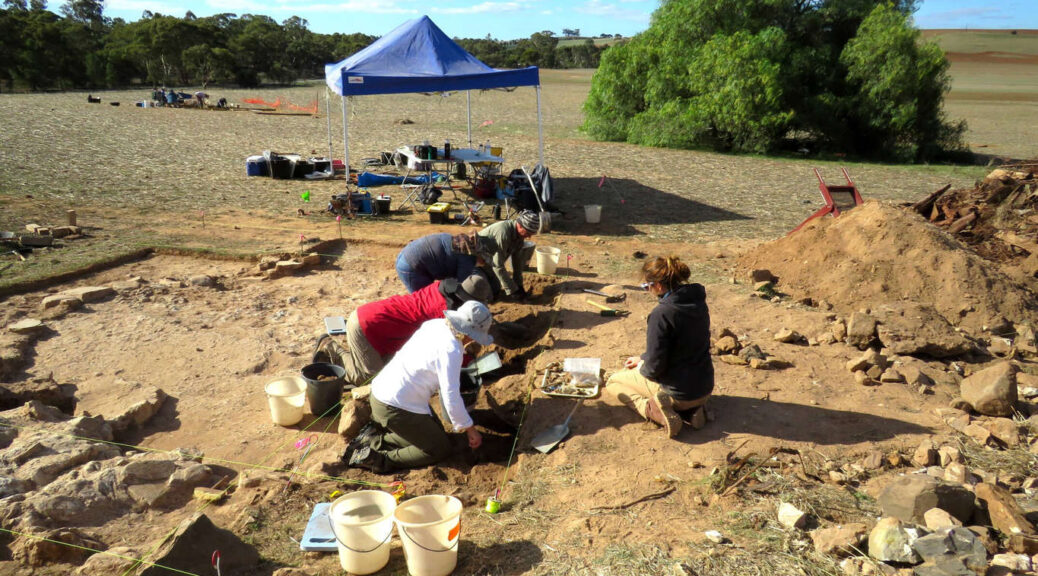Possible Irish Sweathouse Unearthed in Australia
Unlike the world’s great metropolitan centres, ghost towns don’t usually enter sister-city partnerships. But in a paddock north of Adelaide, at a place called Baker’s Flat, there are traces of a village that is, in some ways, an unacknowledged sibling to dozens of similarly half-forgotten hamlets on the other side of the Earth.

“You look at it now and it’s basically a field,” said Irish-Australian archaeologist Susan Arthure.
“There’s no evidence above the ground that all these people were there for nearly 100 years.”
The west of Ireland is today dotted with ghost villages: Settlements emptied by the starvation that swept the land in the 1840s and ’50s, when a combination of crop and political failure caused the deaths of hundreds of thousands and the migration of hundreds of thousands more.
Following the sea lanes, they flocked to London and Liverpool, Boston and Baltimore, Melbourne and Sydney, but also to sites such as Baker’s Flat. But unlike those abandoned villages in Ireland, this village owes its beginnings rather than its decline to the Great Famine.
“The famine was a driving force, it drove migration enormously,” Ms Arthure said.
“The people of Baker’s Flat were predominantly poor and Catholic, and at that time in South Australia they weren’t particularly well-favoured.”
The so-called “clachan” (the Irish word for a clustered communal settlement) that existed at the site has been painstakingly excavated and investigated for more than six years by Ms Arthure.
Ms Arthure is currently putting the finishing touches on her PhD thesis through Flinders University. For her, the clachan remnants are partly a time machine and partly a treasure-trove: They offer glimpses of SA’s colonial past but are also a potential portal into the history of Ireland itself.
Whitewash, whiskey or sweat?
When Ms Arthure began digging at Baker’s Flat, she was expecting to — and did — unearth the remains of the thatched and whitewashed cottages so redolent of Irishness today.
But her most recent research focused on a distinctive round structure that was buried beneath scrap metal.
After initially thinking it may have been for making whitewash, Ms Arthure discounted that hypothesis because “there was no evidence at all of burning or preparing lime” — the basic ingredient in the paint.
Instead, her suspicions shifted to another typically Irish liquid.
“I thought perhaps it might have been an area for a poitín still, where people were distilling illegal whiskey,” Ms Arthure said.
“But one of the roads at the back of Baker’s Flat runs quite close to that area, so it’s not hidden enough.”
At a loss, she consulted experts in Ireland and one of them suggested a sweathouse.
“Sweathouses were very common in Ireland up until probably famine times,” Ms Arthure explained.
“They would be used to deal with illness, to help with rheumatic or arthritic pain, or with fever.”
These semi-subterranean and beehive-like buildings largely died out when modern medicines became more widely available and have “faded from memory” even in the Emerald Isle.
“Given all of the help people have given me, it would be really nice to be able to reciprocate by saying, ‘Here is some information from the SA landscape that maybe can shed some light on sweathouses in Ireland,'” Ms Arthure said.
“What is really exciting about the one here at Baker’s Flat is that we can look not only at how people were following the same traditions, but how they were adapting.”
From heyday to decline
Part of the appeal of Baker’s Flat lay in its proximity to Kapunda’s copper mine, which provided work for the local community. At its peak, as many as 500 people were living there — including a large population from County Clare in the west of Ireland, which was hardest hit by the famine.
Artefacts from the site reveal the richness of its cultural life. In addition to coins, buttons and brooches, there were buckles embossed with cricketers, seemingly in recognition of the local team that was dubbed Hibernian.
“It’s not very well known but, in the 19th century, cricket was one of the most popular sports in Ireland,” Ms Arthure said.
During her research, she identified about 145 family names linked to Baker’s Flat, including Driscoll, Donnellan, McInerney and Conolan.
As those families left for greener pastures, the Baker’s Flat clachan fell into decline and then desuetude, which left only a certain Ms O’Callahan as the last surviving resident.
Local historian Peter Swann, who is 84, recalls visiting her when he was a boy.
“There were only ruins then, except for one old house that this old lady lived in,” he said.
“She lived out there on her own. If you look there now, you see nothing. Everything’s gone.”
Three-quarters of a century before the Irish famine, in an act of astonishing literary prescience, the Anglo-Irish poet Oliver Goldsmith produced an epic called The Deserted Village.
A painted scene from Goldsmith’s poem today hangs in the Art Gallery of SA, and the following quatrain could easily serve as an epitaph for Baker’s Flat and countless sites across Ireland:
While, scourged by famine from the smiling land,
The mournful peasant leads his humble band;
And while he sinks, without one arm to save,
The country blooms—a garden, and a grave.
However, there is a crucial difference between the abandoned villages of Ireland and the clachan at Baker’s Flat.
If the former were sites of sorrow, the latter was emphatically a place of security, vitality and survival.
